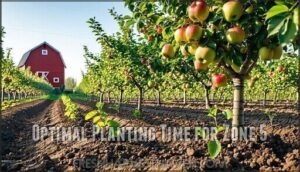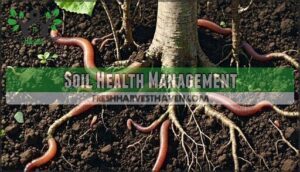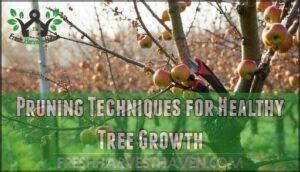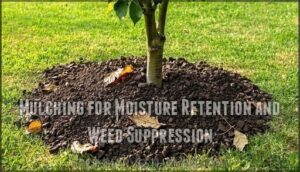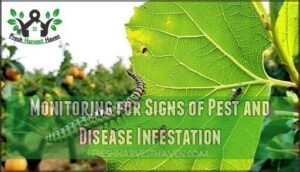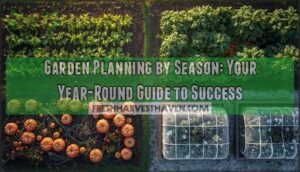This site is supported by our readers. We may earn a commission, at no cost to you, if you purchase through links.
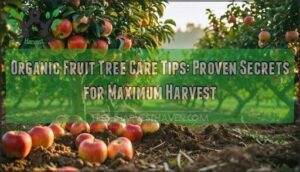
You’ll want to plant before the first hard frost, ensuring proper drainage and full sunlight exposure.
Focus on building rich soil with compost and organic matter while maintaining beneficial microbial activity.
Regular pruning during dormancy promotes airflow and prevents disease.
Apply organic mulch to retain moisture and suppress weeds, but keep it away from the trunk base.
Monitor regularly for pest issues and address them with natural solutions like beneficial insects or organic sprays.
The secret lies in understanding your trees’ seasonal needs and timing your care accordingly to ensure the health and productivity of your fruit trees, which is the key to successful organic fruit tree growth.
Table Of Contents
- Key Takeaways
- Choosing Fruit Trees
- Planting Fruit Trees
- Soil Health Management
- Tree Maintenance and Care
- Frequently Asked Questions (FAQs)
- Is it safe to grow organic fruit trees?
- How to care for fruit trees?
- How do you grow a fruit tree?
- Do fruit trees need soil?
- Should you plan your fruit trees each year?
- How do I make my fruit trees healthy?
- What does baking soda do for fruit trees?
- When should you not fertilize fruit trees?
- How to fertilize fruit trees organically?
- What can I spray on my fruit trees naturally?
- Conclusion
Key Takeaways
- Choose disease-resistant varieties that match your climate zone and soil type – you’ll eliminate most chemical interventions while ensuring reliable harvests from trees like Liberty apples and Kieffer pears that naturally withstand local disease pressures.
- Build healthy soil with organic matter by mixing 2-3 inches of compost annually and maintaining beneficial microbes – you’ll create the foundation for disease resistance and maximum nutrient absorption that your trees need to thrive.
- Prune during dormancy and mulch properly to maintain tree health – you’ll improve airflow, prevent diseases, retain moisture, and suppress weeds by pruning in late winter and applying 2-4 inches of organic mulch away from the trunk.
- Monitor regularly and act early on pest and disease issues – you’ll catch problems before they become major headaches by conducting weekly inspections and using natural solutions like beneficial insects, sticky traps, and organic sprays.
Choosing Fruit Trees
Success starts with choosing the right varieties for your specific growing conditions and harvest goals.
You’ll maximize your organic orchard’s potential by selecting disease-resistant cultivars that match your climate zone and soil type while planning for extended fruiting seasons, which will help achieve extended fruiting.
Selecting Disease-Resistant Varieties
Disease resistance serves as your orchard’s foundation for organic success. Selecting disease-resistant varieties eliminates the need for frequent chemical interventions while ensuring reliable harvests year after year.
Smart growers choose disease-resistant varieties to build naturally resilient orchards.
Strong genetic diversity through heirloom varieties and natural cross-breeding creates trees that naturally withstand local disease pressures. Regional recommendations from extension offices help you choose cultivars proven in your specific climate.
Consider these top disease-resistant options:
- Liberty apples – immune to cedar apple rust and highly resistant to fire blight
- Enterprise apples – strong resistance to apple scab and fire blight
- Pristine apples – immune to apple scab with excellent powdery mildew resistance
- Kieffer pears – exceptional fire blight resistance for organic orchards
- Arapaho blackberries – thornless with natural rust resistance
Rootstock influence affects disease resilience, so choose grafted trees with proven rootstock-scion combinations. Some varieties, like the ‘Goldrush’, exhibit resistance to mildew. Disease-resistant cultivars reduce fungicide applications from ten-plus treatments to minimal interventions, making organic management truly achievable for home growers.
Considering Climate and Soil Type
Beyond selecting disease-resistant varieties, climate adaptation and soil conditions make or break your harvest success. Your USDA zone hardiness determines which regional varieties will thrive—not just survive—in your local climate. Knowing your fruit tree growing zone is essential for selecting plants suited to your area.
Start with soil testing to identify pH levels and drainage patterns. Clay soils need organic amendments for better structure, while sandy soils require compost for moisture retention. Microclimate considerations matter too, as south-facing slopes extend growing seasons.
| Climate Factor | Cold Zones (3-5) | Warm Zones (8-10) |
|---|---|---|
| Best Varieties | Honeycrisp apples, Harrow pears | Citrus, avocados |
| Chill Hours | 800-1,200 hours | Under 400 hours |
| Soil Preparation | Cold-hardy amendments | Heat-tolerant mulching |
Proper soil preparation creates the foundation your trees need to flourish in your specific climate zone.
Opting for Continuous Harvest
Through strategic variety selection, you’ll achieve extended harvests by choosing fruit tree varieties with staggered bloom times and different maturation periods.
Plant early-season apples alongside mid-season pears and late-ripening plums for succession planting success.
Master harvest timing by recognizing ripeness indicators like color changes and gentle fruit separation.
Implement storage solutions and harvest extenders through proper refrigeration and preservation techniques, maximizing your organic bounty throughout the season.
Planting Fruit Trees
You’ve chosen your trees wisely, but proper planting determines whether they’ll thrive or merely survive in your organic orchard.
The location and timing of planting directly impact your trees’ ability to establish strong root systems, resist diseases, and produce abundant harvests for years to come.
Evaluating Topography and Sunlight
Your property’s slope and sunlight determine success before you plant.
Microclimate analysis reveals protected spots where trees flourish despite harsh conditions. Sunlight requirements demand six to eight hours daily for maximum fruit production.
Consider these topography impact factors:
- Sunlight exposure patterns throughout seasons
- Drainage considerations for water flow direction
- Wind protection from natural barriers
- Frost pockets in low-lying areas
- Heat reflection from nearby structures
Smart planting fruit trees means reading your land’s natural story first.
Assessing Soil Quality and Drainage
Before planting your fruit trees, conducting soil composition tests reveals critical insights about your growing foundation.
Test pH levels using a simple meter—fruit trees thrive between 6.0-7.0.
Perform the jar test to assess soil drainage: poor drainage causes root rot, while sandy soil needs organic amendments for moisture retention.
Early detection can help with diagnosing fruit tree problems.
Check for nutrient deficiency detection through visual cues and testing kits, then improve soil conditions with compost and aged manure to boost microbial activity.
Optimal Planting Time for Zone 5
Spring planting wins for Zone 5 organic fruit tree success.
March to May offers ideal conditions when soil temperatures stay above freezing and trees remain dormant.
This timing maximizes root establishment before summer stress hits, and local nurseries stock cold-hardy varieties perfectly timed for your frost dates.
Spring vs. fall is an important consideration, as spring eliminates winter risks while meeting chilling hours naturally.
Soil Health Management
Your fruit trees’ success starts in the soil, where proper nutrition and microbial activity create the foundation for disease resistance and maximum yields.
Healthy soil management involves three key practices: enriching with organic matter, fostering beneficial microorganisms, and providing targeted nutrients through natural fertilizers, which create the foundation for disease resistance.
Amending Soil With Organic Matter
Your soil craves organic matter like a hungry sponge soaking up water.
Transform your earth with these proven amendments:
- Compost Application – Mix 2-3 inches of finished compost into the top 12-18 inches of soil annually for improved soil structure and nutrient release.
- Manure Usage – Apply well-aged manure (6+ months old) to boost soil fertility without risking nitrogen burn on tender roots.
- Cover Cropping – Plant nitrogen-fixing legumes like clover between seasons to naturally enhance soil health and feed beneficial soil microbes while maintaining ideal pH balance.
These legumes can also aid in nitrogen fixation processes.
Maintaining Healthy Soil Microbial Diversity
Once you’ve improved your soil with organic matter, focus on building a thriving Microbe Food Web beneath your trees. Microbial diversity creates natural pest resistance and enhances nutrient absorption. Think of beneficial microbes as your soil’s workforce—they need proper conditions to flourish.
Here’s how to nurture your soil food web:
- Brew Compost Tea Benefits by steeping finished compost for 24-48 hours
- Inoculate with Mycorrhizal Networks to extend root reach by 100x
- Practice Avoiding Soil Compaction by using designated pathways around trees
- Apply Diverse Mulch Types like wood chips, leaves, and grass clippings
- Minimize disturbance when adding organic soil amendments
This approach maintains soil health year-round.
Using Organic Fertilizers for Nutrient Supplementation
While organic tree fertilizer feeds your fruit trees, understanding which type works best guarantees maximum harvest.
Different organic fertilizers serve specific purposes and timing needs.
| Fertilizer Type | Primary Benefit |
|---|---|
| Bone Meal Benefits | Slow phosphorus release for root development |
| Fish Emulsion Use | Quick nitrogen boost for spring growth |
| Cover Crop Nutrients | Natural soil building through winter months |
Compost vs Manure shows compost provides balanced nutrition while manure delivers higher nitrogen content.
Apply bone meal during fall planting, fish emulsion monthly during growing season.
To find the best option, consider exploring options for buying tree fertilizer.
Soil retesting annually helps identify nutrient deficiencies before they impact soil fertility.
Fruit tree fertilizer works best when matched to your tree’s growth stage and seasonal needs.
Tree Maintenance and Care
Once your fruit trees are established, maintaining their health becomes your primary focus for ensuring bountiful harvests year after year.
Proper tree maintenance combines strategic pruning, effective mulching, and vigilant pest monitoring to create an environment where your trees can thrive naturally without chemical interventions, which is crucial for bountiful harvests.
Pruning Techniques for Healthy Tree Growth
Mastering fruit tree pruning during dormancy pruning season transforms your harvest potential. Sanitized tools prevent disease spread between cuts, while proper branch selection and training young trees establishes strong frameworks.
Consider using the best fruit pruners for the job. Focus on these essential pruning techniques:
- Remove dead, diseased, or crossing branches first
- Create 45-90° branch angles for ideal fruit production
- Thin crowded areas for airflow improvement
Perfect pruning timing occurs late winter through early March when trees remain dormant yet healing accelerates quickly.
Mulching for Moisture Retention and Weed Suppression
Beyond pruning, mulching creates a protective barrier that transforms your fruit tree’s growing environment.
Apply organic mulches like wood chips, straw, or shredded leaves at 2-4 inch application depth, keeping material away from the trunk.
Different mulch types offer varying decomposition rates—wood chips last longer while leaves break down faster, enriching soil.
This practice excels at moisture retention and weed suppression while supporting water conservation.
Consider various product options for your specific needs.
Smart organic weed control reduces competition for nutrients, letting your trees thrive naturally.
Monitoring for Signs of Pest and Disease Infestation
Anyone can spot a sick tree, but catching problems early requires dedication and the right approach.
Weekly regular inspections form the backbone of effective disease prevention and natural pest control.
During these walks, examine leaves for disease symptoms like brown spots with yellow halos or curled, sticky foliage indicating fruit tree pests.
Check bark for entry holes, oozing sap, or tiny frass pellets that signal borer activity.
Early detection through careful pest identification prevents minor issues from becoming major headaches.
To aid in this process, consider using apps that assist with garden pest identification.
Use sticky traps and pheromone lures to monitor pest populations, while maintaining good sanitation by removing fallen fruit and debris.
These preventative measures and consistent organic pest control practices keep your orchard healthy naturally.
Frequently Asked Questions (FAQs)
Is it safe to grow organic fruit trees?
Growing organic fruit trees is safer than swimming with sharks in your backyard pool.
You’ll avoid harmful pesticides while creating nutrient-rich soil through composting and natural amendments.
Ensuring healthy trees that resist diseases naturally without chemical interventions, is a key benefit of this approach, making it a more natural way to grow fruit trees.
How to care for fruit trees?
You’ll want to test your soil first, then add compost annually while maintaining proper pH levels.
Prune during winter dormancy, make certain of adequate sunlight, and select disease-resistant varieties for your climate zone.
How do you grow a fruit tree?
Like nurturing a seedling into a mighty oak, you’ll plant your fruit tree in well-draining, pH-balanced soil enriched with compost.
Ensuring six hours of daily sunlight and proper spacing for airflow.
Do fruit trees need soil?
Fruit trees absolutely need soil – it’s their lifeline for nutrients, water, and root support.
You’ll want well-draining, organic-rich soil with a pH between 0-0 for ideal growth and fruit production.
Should you plan your fruit trees each year?
Ironically, while you can’t literally plant trees annually like vegetables, you should definitely plan your fruit tree care each year.
Create schedules for pruning, fertilizing, and pest management to maximize harvests and tree health.
How do I make my fruit trees healthy?
Test your soil pH and add compost annually. Choose disease-resistant varieties suited to your climate. Prune during dormancy, make certain proper spacing for airflow, and maintain consistent watering without overwatering.
What does baking soda do for fruit trees?
Think of baking soda as your tree’s natural armor against fungal foes.
You’ll spray a diluted solution (1 tablespoon per gallon) to create an alkaline barrier that prevents powdery mildew and other fungal diseases from taking hold, acting as a natural defense mechanism, or natural armor, for your tree.
When should you not fertilize fruit trees?
Avoid fertilizing fruit trees during late summer through fall, as this encourages tender new growth vulnerable to frost damage. Skip fertilizing drought-stressed, newly planted, or dormant trees.
How to fertilize fruit trees organically?
Feed your fruit trees with compost, aged manure, or organic fertilizers like blood meal and bone meal.
Apply in early spring before growth begins, ensuring you don’t over-fertilize by following package directions carefully, and remember to use organic fertilizers.
What can I spray on my fruit trees naturally?
You can spray compost tea, neem oil, horticultural oils, or soap solutions on fruit trees naturally to control pests and diseases while maintaining organic practices.
Conclusion
Successfully implementing these organic fruit tree care tips transforms your backyard into a productive orchard sanctuary.
You’ll discover that consistent attention to soil health, proper pruning schedules, and natural pest management creates resilient trees.
Remember, patience pays dividends—your trees need time to establish strong root systems and mature fruiting habits.
By following these proven methods, you’re investing in years of abundant, chemical-free harvests that’ll make your neighbors green with envy.
- https://www.marthastewart.com/how-to-fertilize-fruit-trees-11740219
- https://www.starkbros.com/growing-guide/article/fertilizing-organic-fruit-trees
- https://ask.extension.org/kb/faq.php?id=802087
- https://www.precisiontreemn.com/tips/how-to-care-for-fruit-trees-in-the-summer.html
- https://simplifylivelove.com/caring-for-fruit-trees-organically/



